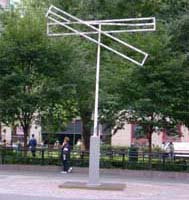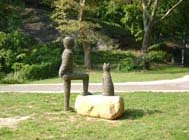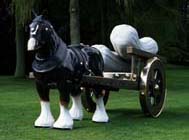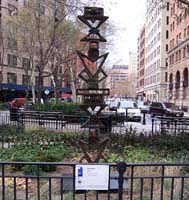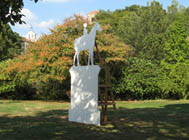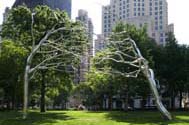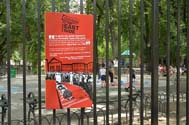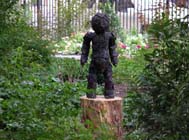Art in the Parks
Through collaborations with a diverse group of arts organizations and artists, Parks brings to the public both experimental and traditional art in many park locations. Please browse our list of current exhibits and our archives of past exhibits below. You can also see past grant opportunities or read more about the Art in the Parks Program.
Public Art Map and Guide
Find out which current exhibits are on display near you, and browse our permanent monument collection.
Search Current and Past Exhibits
2007
Manhattan
George Rickey, Two Open Rectangles
October 1, 2007 to April 23, 2008
Union Square Park, Manhattan
Please note: This is a past exhibit that is no longer installed in the park.
Two Open Rectangles, a stainless steel kinetic sculpture, is made to move gently in response to any gust of wind. In this way, the sculpture, like other kinetic work in the artist’s oeuvre, translates the transitory nature of the wind’s movement into the more physical form of steel.
George Rickey (1907-2002) began his career as a painter in the cubist style. He later changed mediums and began his career in sculpture, starting with mobiles. Rickey’s mobile work eventually became the large, steel, kinetic forms for which he is most well-known. His work was included in the 1967 exhibition Sculpture in Environment.
Presented by Marlborough Chelsea.
![]()
Boaz Vaadia, Asa, Ba'al & Yizhaq, Yo'ah with Dog, Asaf; and Asaf & Yo'ah, Amaryahu
October 1, 2007 to April 22, 2008
Morningside Park and Broadway Malls at 114th and 117th streets respectively, Manhattan
Please note: This is a past exhibit that is no longer installed in the park.
Boaz Vaadia’s group of bronze and bluestone boulder sculptures placed throughout Morningside Park and two locations on the Broadway Malls create collectively, as the artist says, a “contemplative connection between various communities.” The works are site-specific in that the materials Vaadia uses, slate, shingle, bluestone (here cast in bronze), are all materials that are found in the native geology of the New York City area. Vaadia’s working method of hand-carving and then stacking layers of stone to create his forms recalls ancient methods of stone-carving and construction. For select works, Vaadia then continues the process by casting the original stone sculpture in bronze.
![]()
Sarah Lucas, Perceval
November 15, 2007 to April 22, 2008
Doris Freedman Plaza
Central Park, Manhattan
Please note: This is a past exhibit that is no longer installed in the park.
Perceval is a life-sized horse and cart, a replica of the sort of china ornament that have had pride of place on many British mantelpieces. Scaled up, the horse is majestic in his power but offers an unthreatening sense of stolid comfort in his benign reliability. In the proudly fashioned cart are two concrete cast squashes, outsize and off-scale, fertility symbols implicating a competitive rural contest to rival the ritual of the maypole. These giant vegetables are cast in cement, one of Lucas’s favored materials, and take the replication of the horse and cart knick-knack away from kitsch, the crudeness of this signature Lucas gesture thrown into sharper relief by the high finish of the bronze sculpture.
Perceval reflects a fascination for Englishness evident in much of Lucas’s work. The title is borrowed from the name of one of King Arthur’s Knights of the Round Table. Raised in a forest by his mother, the virtuous and noble Perceval meets the knights as they pass and goes off the join them, later becoming involved in the quest for the Holy Grail. The story has been reworked in various contemporary versions, notably Eliot’s The Wasteland and Wagner’s opera Parsifal, in which version the eponymous hero is the one to recover the spear used to pierce Christ during his crucifixion.
Sarah Lucas is one of the most significant contemporary women artists working in London today. She is among the group of artists who are credited with being a catalyst for the Young British Artist (YBA) movement, which has brought to light the likes of artists including Damien Hirst, Gary Hume, Tracey Emin, and others. Her work has been exhibited in numerous museums, including Tate Modern in London, Kunsthalle Zurich, Kunstverein Hamburg, and others.
This installation is a project of the Public Art Fund.
![]()
Angel Orensanz, The Garden Before the Snake
September 1, 2007 to March 31, 2008
Dag Hammarskjold Plaza, Manhattan
Please note: This is a past exhibit that is no longer installed in the park.
The steel-pipe sculpture group by the artist Angel Orensanz, The Garden Before the Snake, is an expression of the artist’s concept of a "garden." Orensanz has described The Garden "as a utopian horizon for humankind’s endless growth and harmony" with the foil of "the serpent" or the "snake" acting as a representation of the "fragility" and "fragile future" of humankind.
Spanish-born Orensanz is likely best known for his purchase and refurbishment of a circa 1849 unused synagogue on Norfolk Street in New York City’s Lower East Side. Orensanz first used this as his studio, and then in 1992, along with his brother and several other artists, established the Angel Orensanz Foundation. The Foundation now occupies the building.
![]()
Kenny Scharf, Totemikon
December 6, 2007 to March 30, 2008
Tribeca Park, Manhattan
Please note: This is a past exhibit that is no longer installed in the park.
Kenny Scharf’s bronze sculpture Totemikon riffs on the traditional form of a totem pole. As the title suggests, the sculpture explores themes of “totems” and “icons” as seen through Scharf’s aesthetic, which is very much informed by pop and contemporary-culture influences.
Scharf rose to prominence in the 1980s New York art world. The artist was part of a group of dynamic artists, including Jean-Michel Basquiat and Keith Haring. Scharf’s work often employs a cartoon or cartoon-like aesthetic, using that seemingly childlike style to comment on adult themes.
Presented by Paul Kasmin Gallery.
![]()
Melora Kuhn, Monument
October 3, 2007 to March 30, 2008
Fort Tryon Park, Manhattan
Please note: This is a past exhibit that is no longer installed in the park.
Kuhn’s sculpture for the Cloisters Lawn is a monumental wooden cut-out in the silhouette of a grand, equestrian memorial statue. The artist recasts this classic image of the hero into an examination of what has been left out or forgotten in our histories. It forcibly reinterprets the idea of the vanquisher. Kuhn chose Fort Tryon Park for Monument in part because its physical geography—high on a hilltop—enhances the association of the conquering figure. In addition, the proximity of the Cloisters lends further connection to the history of Western regimes (including the advent of the American industrialists who took as their “spoils” the art and architecture of past European empires). Finally, the artist adds that the diverse communities of the surrounding neighborhoods speak to the many cultures whose histories are often overlooked in the narrative of the subjugating Western men that still dominates our textbooks.
Kuhn was born in 1971 in Boston and now lives in Brooklyn and works in Long Island City. She has a BFA from the Art Institute of Chicago and has trained in Italy at La Cipressaia, Montagnana, and Scuola Lorenzo di Medici in Florence. She has had solo exhibitions of her work in New York, San Francisco, and Boston, with a show in Seoul, Korea scheduled for October 2007.
This project was organized by ZieherSmith Gallery and made possible by the Fort Tryon Park Trust.
![]()
Hans Van de Bovenkamp, Cloud Kicker
October 1, 2007 to March 16, 2008
Dante Park, Manhattan
Please note: This is a past exhibit that is no longer installed in the park.
Like many of his works, Van de Bovenkamp’s Cloud Kicker was inspired by organic forms—in this case, the sky. The sculpture was made from stainless steel, a material the artist likes for its strength and contemporary appearance, as well as its reflective quality that modifies the work’s appearance as the light changes throughout the day.
Born in 1938 in Garderen, Holland, Van de Bovenkamp trained first as an architect and then studied sculpture at the University of Michigan. Upon graduating from college in 1961, Van de Bovenkamp moved to New York City in order to pursue his dream of becoming a sculptor. Select one-person shows and group exhibitions include the Arlene Bujese Gallery, East Hampton, NY; New Leaf Gallery, Berkeley, CA; Kouros Sculpture Garden, Ridgefield, CT; Louis K. Meisel Gallery in New York, NY; and Sagaponack Sculpture Fields, Sagaponack, NY. Additionally, Van de Bovenkamp’s works are featured in numerous corporate, museum, university, and public collections.
This project was organized by the Louis K. Meisel Gallery.
![]()
Roxy Paine, Conjoined, Defunct, and Erratic
May 15, 2007 to February 28, 2008
Madison Square Park, Manhattan
Please note: This is a past exhibit that is no longer installed in the park.
Roxy Paine’s three works: Conjoined, a 40 foot-tall sculpture of two intertwined trees; Defunct, a 42 foot-tall sculpture of a lone tree that appears to be under attack from the shelf-fungus growing on it’s trunk; and Erratic, a boulder measuring 7 feet high by 15 feet wide, are part of a larger series of works by the artist. These works come out of the artist’s interest in the interactions between humans and nature and specifically from Paine’s examination of nature through the lens of industrial processes.
Presented by Mad. Sq. Art, a program of the Madison Square Park Conservancy.
![]()
City Lore, Your Guide to the Lower East Side
September 10, 2007 to February 28, 2008
Straus Square
Seward Park, Manhattan
Please note: This is a past exhibit that is no longer installed in the park.
Your Guide, a joint project between Place Matters, the Lower East Side Tenement Museum, and the Lower East Community Preservation projects, seeks to illuminate small moments in the larger history of the neighborhood. The Your Guide project uses graphically interesting signs to tell first-person stories generated from interviews with current and past neighborhood residents. These signs promote insider perspectives, allowing residents and visitors alike to feel a sense of intimacy and welcome; the project enables viewers to feel as if they are sharing in a story rather than getting a history lesson.
![]()
Kent Henricksen, Playing with Feathers
October 1, 2007 to January 5, 2008
Manhattan
Please note: This is a past exhibit that is no longer installed in the park.
Kent Henricksen’s Playing with Feathers, a playful-yet-disturbing, smaller than life-size bronze sculpture, has taken up temporary residence in Seward Park. The bronze, of a small figure covered in feathers, speaks to the integration of fantasy and reality, evoking both the playfulness of imagination and the disquiet of the strange and unknown.
Henricksen’s work is currently on view through October 6, 2007 at John Connelly Presents in "Divine Deviltries," the artist’s second solo show at the gallery.
![]()
